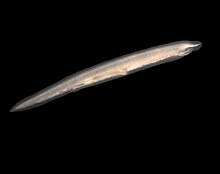Branchiostoma lanceolatum
| Branchiostoma lanceolatum | |
|---|---|
 |
|
| Branchiostoma lanceolatum | |
| Scientific classification | |
| Kingdom: | Animalia |
| Phylum: | Chordata |
| Subphylum: | Cephalochordata |
| Class: | |
| Order: | Amphioxiformes |
| Family: | Branchiostomidae |
| Genus: | Branchiostoma |
| Species: | B. lanceolatum |
| Binomial name | |
|
Branchiostoma lanceolatum (Pallas, 1774) |
|
| Synonyms | |
|
|
Branchiostoma lanceolatum (European lancelet) is a lancelet in the subphylum Cephalochordata. It is a marine invertebrate found in soft substrates in shallow seas. It is used as a model organism to study the development of vertebrates. The genome has been sequenced.
Branchiostoma lanceolatum has an elongated body, flattened laterally and pointed at both ends. A stiffening rod of tightly packed cells, the , extends the whole length of the body. Above it is a nerve cord with a single frontal eye. The mouth is on the underside of the body and is surrounded by a tuft of 20 or 30 cirri or slender sensory appendages. The gut runs just below the notochord from the mouth to the anus, in front of the tail. There is a flap-like, vertical fin surrounding the pointed tail. Gas exchange takes place as water passes through gill slits in the mid region, and segmented gonads lie just behind these. The animal is pearly white and semi-transparent which enables the internal organs to be seen from outside. Its appearance is similar to a "primitive fish". It can grow up to 6 cm (2.5 in) long.
Branchiostoma lanceolatum is found in shallow seas in the north-east Atlantic Ocean, from Norway, Scotland as well as further south to the Mediterranean Sea and the Black Sea. Its range has expanded through the Suez Canal to the northerly parts of the Indian Ocean and the coasts of East Africa. It burrows in soft substrates such as sand, gravel and shell fragments and is quite particular as to the size of the particles. It occurs from the low tide mark down to about 40 metres (130 ft).
In the North Sea, breeding takes place in June and July. The mature adult Branchiostoma lanceolatum, aged 2 to 3 years, congregate in masses on the sea floor. Individuals are either male or female and spawn once a year. The eggs are laid and fertilisation takes place externally. The early larval stages take place in the substrate but a little later, the larvae become pelagic. They are elongated and flattened laterally and have a swollen region around the gill slits. These slits number 6 to 19, the number increasing as the larva passes through its various stages. The larvae have a vertical daily migration. Each evening they rise to near the surface of the sea and in the morning they sink through the water column, feeding on phytoplankton, copepods and detritus as they descend. While in these surface waters they drift with the current. The larval stage lasts for up to 200 days.
...
Wikipedia
